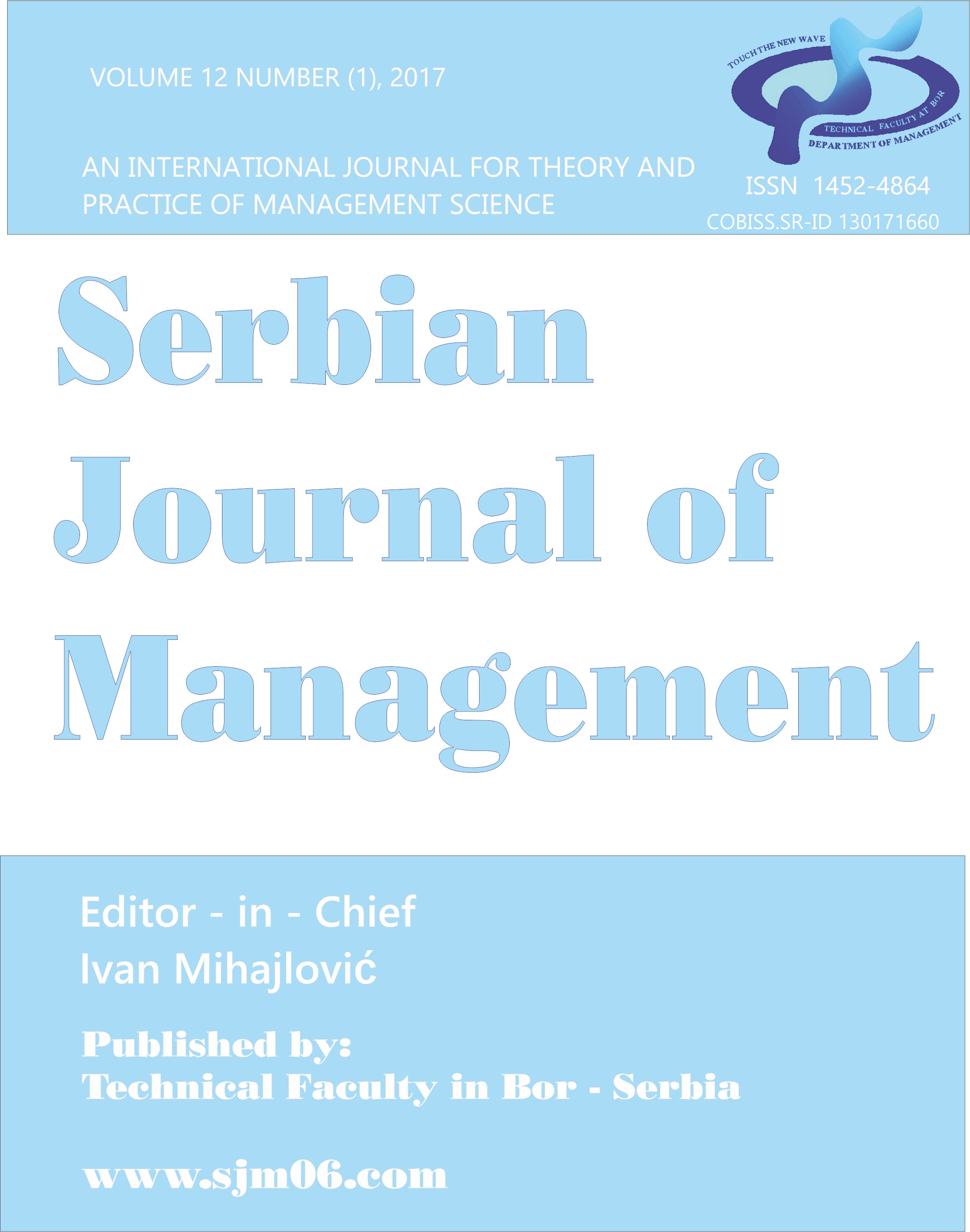Дијалектика сложености, настанка и управљања
Sažetak
Чланак је посвећен дијалектичкој анализи таквих фундаменталних суштина савремених организација као што су сложеност, настанак и управљање. Приступе квантитативној процени сложености разматра као конструктивну особину система, при чему скреће пажњу на чињеницу да је сложеност директан резултат развоја способности система за прилагођавање. Појаву насталих својстава у организацији прати неминовно повећање њене сложености. Овај раст треба контролисати и регулисати, а ниво настанка организације треба да одговара сложености окружења. Што више неизвесности треба да се елиминише, организациони систем постаје сложенији. Са становишта аутора, дијалектика ентропије, сложености и појаве је следећа – јачање насталих својстава скупа елемената захтева минимизирање ентропије. Заузврат, минимизирање ентропије захтева сврсисходно ограничавање слободе понашања елемената система, што се обезбеђује уграђивањем у систем управљачких елемената и организовањем потребног скупа веза, а то доводи до повећања сложености организације.
Reference
Alligood, K.T., Sauer, T.D., & Yorke, J.A. (1996). Chaos: An Introduction to Dynamical Systems, Textbooks in mathematical sciences. Springer, New York, NY.
Burnes, B. (2005). Complexity theories and organizational change. International Journal of Management Reviews, 7 (2), 73-90.
Derkatsch, A., Maa, M., & DeTurris, D. (2022). Managing Complexity Through Communication in High Reliability Organizations. AIAA SCITECH 2022 Forum.
Eloranta, V., Ardolino, M., & Saccani, N. (2021). A complexity management approach to servitization: the role of digital platforms. International Journal of Operations & Production Management, 41 (5), 622-644.
Espejo, R. (2015a). An Enterprise Complexity Model: Variety Engineering and Dynamic Capabilities. International Journal of Systems and Society, 2 (1), 1-22.
Espejo, R. (2015b). Performance for viability: complexity and variety management. Kybernetes, 44 (6/7), 1020 – 1029.
Espejo, R. (2018). An Enterprise Complexity Model: Enterprises, Organizational Systems, and Dynamic Capabilities. In Stowell, F. (Ed.), Systems Research for Real-World Challenges. IGI Global. 1-32.
Fonseca Albuquerque Cavalcanti Sigahi, Tiago. (2021). The movement of complexity sciences into organization studies: A literature mapping. XXXIX ENCONTRO NACIONAL DE ENGENHARIA DE PRODUCAO “Os desafios da engenharia de produção para uma gestão inovadora da Logística e Operações” Santos, São Paulo, Brasil, 15-18 October 2019
Fu, Y., Xu, C., Zhang, L., & Chen, Y. (2023). Control, coordination, and adaptation functions in construction contracts: A machine-coding model. Automation in Construction. 152. 104890.
Holland J.H. (1995). Hidden Order: How Adaptation Builds Complexity. Addison-Wesley, New York, NY.
Modarres, M. (2023). The Contingent Effects of Structural Complexity and Organizational Size on Administrative Reorganization Under Conditions of Organizational Growth and Decline. Academy of Management, 35.
Pavlov, A., & Micheli, P. (2022). Rethinking organizational performance management: a complexity theory perspective. International Journal of Operations & Production Management, 43 (6), 899-915.
Phillips, M.A., & Ritala, P. (2019). A complex adaptive systems agenda for ecosystem research methodology. Technological Forecasting and Social Change, 148, 119739.
Popov, N.E. (2022). Influence of product complexity on sustainable development of industrial enterprises. Vestnik of Astrakhan State Technical University. Series: Economics, 4, 123-129.
Reeves, M., Levin, S., Fink, T., & Levina A. (2020). Taming Complexity. Harvard Business Review. Retrieved from: https://hbr.org/2020/01/taming-complexity
Rostami, M., & Bucking, S. (2021). A Framework for Integrating Reliability, Robustness, Resilience, and Vulnerability to Assess System Adaptivity. International Mechanical Engineering Congress and Exposition, 1-5 November, 2021.
Schott, P., Lederer, M., Eigner, I., & Bodendorf, F. (2020). Case-based reasoning for complexity management in Industry 4.0. Journal of Manufacturing Technology Management, 31 (5), 999-1021.
Simpson, J. (2015). Taming organisational complexity—start at the top. Economist Impact. Retrieved from: https://eiuperspectives.economist.com/strategy-leadership/taming-organisational-complexity/article/taming-organisational-complexity—start-top.
Skowroński, Dominik. (2022). Organization Meta-Design Model. Zeszyty Naukowe Wyższej Szkoły Humanitas Zarządzanie, 23 (4), 155-168.
Son, J. (2022). Complexity and Dynamics in Construction Project Organizations. Sustainability, 14 (20), 13599.
Tainter, J.A. (1990). The Collapse of Complex Societies. Cambridge University Press.
Worren, N. (2018). Organization Design: Simplifying complex systems (2nd ed.). Routledge.
The Author wishes to submit the Work to SJM for publication. To enable SJM to publish the Work and to give effect to the parties’ intention set forth herein, they have agreed to cede the first right to publication and republication in the SJM Journal.
Cession
The Author hereby cedes to SJM, who accepts the cession, to the copyright in and to the paper.
The purpose of the cession is to enable SJM to publish the Work, as first publisher world-wide, and for republication in the SJM Journal, and to grant the right to others to publish the Work world-wide, for so long as such copyright subsists;
SJM shall be entitled to edit the work before publication, as it deems fit, subject to the Authors approval
The Author warrants to SJM that:
- the Author is the owner of the copyright in the Work, whether as author or as reassigned from the Author’s employee and that the Author is entitled to cede the copyright to SJM;
- the paper (or any of its part) is not submitted or accepted for publication in any other Journal;
- the Work is an original work created by the Author;
- the Author has not transferred, ceded, or assigned the copyright, or any part thereof, to any third party; or granted any third party a licence or other right to the copyright, which may affect or detract from the rights granted to SJM in terms of this agreement.
The Author hereby indemnifies the SJM as a body and its individual members, to the fullest extent permitted in law, against all or any claims which may arise consequent to the warranties set forth.
No monetary consideration shall be payable by SJM to the Author for the cession, but SJM shall clearly identify the Author as having produced the Work and ensure that due recognition is given to the Author in any publication of the Work.
Should SJM, in its sole discretion, elect not to publish the Work within 1 year after the date of this agreement, the cession shall lapse and be of no further effect. In such event the copyright shall revert to the Author and SJM shall not publish the Work, or any part thereof, without the Author’s prior written consent.

